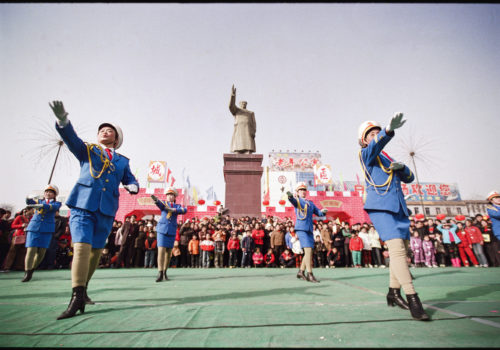Created by young Beijing Red Guards in 1967 at the height of the Cultural Revolution, the first Mao Statue with outstretched arm was erected at the entrance of Tsinghua University after they have destroyed a historical imperial archway. It was supposed to celebrate the Victory of the thought of Chairman Mao. A calligraphy hand-written by Marshall Lin Biao, the architect of Mao’s Personality Cult, was engraved at the base of the statue saying: “Chairman Mao Waves, I advance” dedicated to the Four Greats (四个伟大): “to Great Mentor, Great Leader, Great Commander, Great Helmsman”.
Soon replica of this statue spread like wild fire across the country, cities and townships started erecting Mao statues that became the most eminent example of personality cult. A decade later, by the end of the Cultural Revolution and during the 1980’s thousands of these statues were removed from their pedestals, taken down and buried in the countryside, some only resurfaced due to the recent fever of real-estate development.
Nobody really has an accurate account of how many Mao statues have been produced, an article in China Daily mentioned that some 190 statues survived today. The best known one measuring 30-meter erected in 1968 still stands in the center of Chengdu, sculpted out of solid white marble hailed from the quarry of Panzhihua, a city famous for its place during the Long March. The irony is that with better living standard and the emergence of very rich Chinese entrepreneurs, Mao statue has become fashionable again, even more popular than a statue of Buddha, for around 5,000 US dollars one can order a 3-meter tall Mao statue for a private collection or for gift.
At the 2016 Pingyao Festival an extraordinary exhibition showcased a 30-year photography saga of a city square at the foot of a Mao Statue. Self-taught photographer and traveling salesman Chen Zhixian born in Wenzhou and now living in Shanghai, found himself in the city of Jincheng in 1985 by pure coincidence on the eve of Chinese New Year, he went out and took pictures of the crowd in the People’s Square and recorded the festival atmosphere around the Mao statue. From then on, Jincheng became his yearly pilgrimage. Curator Robert Pledge wrote: “He photographed it. Relentlessly. Year after year. He walked us through the square from black-and-white to color, from film to digital.”
And we can see the fascinating changes that take place in an ordinary city of China over three decades, like an accelerated slideshow except for the central figure standing still in the middle of the square. From the fleet of bicycles and three-wheeled carts replaced by to today’s urban disease such as overflow of advertising boards and heavy traffic jam. “Pedestrian snaking their way around SUVs, motorbikes, and brightly colored buses. High-rises, fast food restaurants, hair salons and neon lights shape the new urban landscape.” Bob Pledge has written in his foreword.
My favorite picture is this one taken in 2009, that shows a young woman, a friend of the photographer’s, in a flowery summer dress with a naive green ribbon on the chest in a nostalgic style, standing with her back against the Mao statue, raising her left arm as if to shield her face from the sun, her arched elbow echoing the raised arm of the Great Leader, pointing to a red banner on top of a building that says “New World, Re-writing the City Main”. On the ground floor of the building lies another red banner: the newly opened Kentucky Fried Chicken. The square lives up to its name “The People’s Square”, by attracting, as Chen’s later pictures show, festive parades and popular night hawkers market, and so-called “Square dance” where people gather in groups for exercise or social dance. One statue, one square, summarize the daily common urban life of so many Chinese cities.
Jean Loh
Jean Loh is a journalist specializing in photography and based in Beijing, China.
Chen Zhixian
December 10, 2016 to January 10, 2017
Inter Gallery
4 Jiuxianqiao Rd, Chaoyang Qu
Beijing Shi, China, 100015
















